I’m fighting for freedom of speech. I never settle for less. I don’t engage in negotiation.
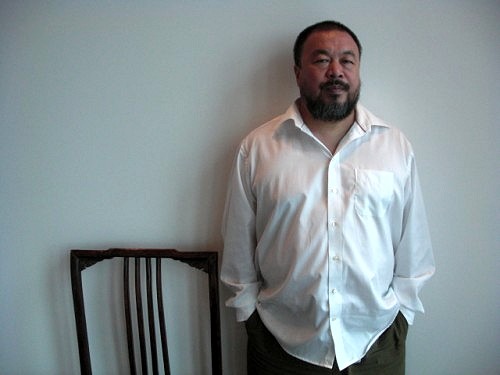
Artist/architect/activist Ai Weiwei
Presenting one topical work after another at international shows, designing the ‘Bird’s Nest’ stadium for the Beijing Olympics, while on the other hand having his blog shut down by the authorities for his fierce criticism of the Games…Ai Weiwei, artist who is also architect and activist, visited Japan recently for a solo exhibition at the Mori Art Museum. We took the opportunity to quiz one of the leading figures in Chinese contemporary art on his views of art, the state, and life.
Interview: ART iT
– I understand you were given two books on Western art as a youth – one on Van Gogh, Degas and Manet and the other on Jasper Johns – which you shared with a circle of artists in Beijing, but then tossed the Jasper Johns book in the trash. Still you’ve chosen the title of his work, According to what?, as the title for your current retrospective…
I got the books in the late 1970s. They were very precious because nobody in China had foreign art books at the time. But nobody understood Jasper Johns’ work – red, yellow, blue: What is this? It was so different from our education, which was purely representational.
But once I went to the United States, I encountered Jasper Johns’ work again. I saw Flag at the Whitney Museum and the flag on flag, and I bought his book and started to read it. I became very interested in his approach to images – that he never created images, but just appropriated images from culture to create other images. He said we never change the subject; only our interpretation.
Through Johns I started reading Marcel Duchamp and Wittgenstein’s books on language and philosophy. Both resonated with me, which is very strange because neither had anything to do with the Oriental experience.
I like Jasper Johns’ work very much, although According to what? is his work I hate most (laughs).
A reluctance to be related to history
– I’ve also heard that you were inspired to do architecture after reading Wittgenstein’s book.
Yes. I never studied architecture. But before I went back to China I went to a bookshop and bought an old book about Wittgenstein’s architecture – the house he designed for his sister in Vienna. I was somehow very attracted to that book.
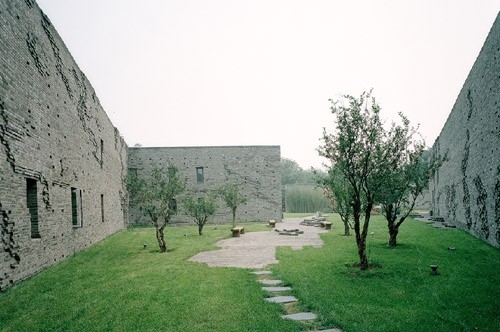
Three Shadows Photography Center, Caochangdi, Beijing 2007
Designed by Ai Weiwei / FAKE Design
– Wittgenstein’s architecture is very modern, the forms very simple, very minimal. Did you find any references or familiar sense of style in Wittgenstein’s architecture?
No. I feel it as more of a religious act. It has symbolic meaning for me. But I never really followed his path. I think what I like is the clarity. To give definition to what needs talking about, the message has to be absolutely clear.
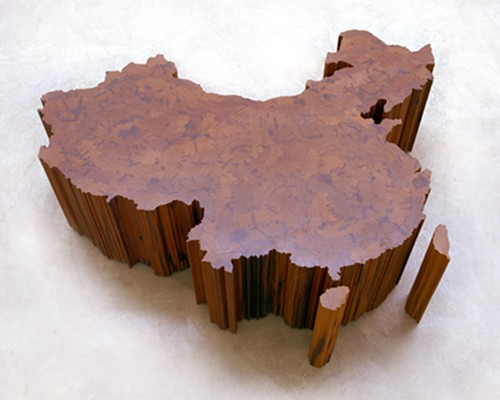
Map of China 2004
Tieli wood from dismantled Qing-dynasty temples assembled using traditional Chinese joinery
51 x 200 cm © FAKE Studio
– Much of your work relates to time, history and memory, especially the iconic Template that you showed at the last documenta. Is the same true of your architecture?
Personally I hate to relate my work to history. I don’t have memories…my memory is very bad. And normally I don’t like historical meaning in art. But somehow it has become very much related to my practice – even if it wasn’t always intentional. It’s easy to come back to these subjects. There’s comfort, but also questioning, borrowing or using these references as evidence of human fallacy.
Chinese society: unstable and dangerous
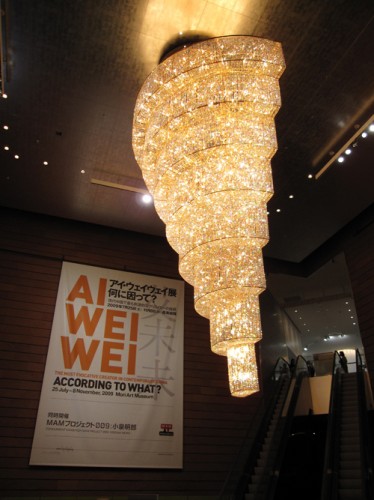
Chandelier 2009
Glass crystals, lights, metal 600×450 225cm
Installation view at Ai Weiwei: According to What?
– Can you tell us about your show here in Tokyo?
Most of the works in the exhibition are being shown for the first time. Believe it or not, this is my first comprehensive museum exhibition. I’ve never had a show in China, even though I’ve been working there for fifteen years. Single pieces here and there, yes, but never a major show. So this is the first time I’m seeing all the pieces together. I’m like a new starter, I feel like a young person.
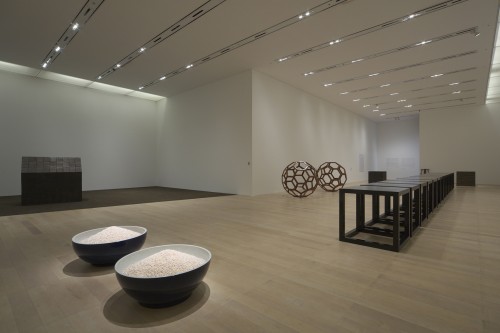
(Left to right) Teahouse 2009, 432 pressed tea cubes; Bowl of Pearls 2006; Untitled 2006,
Cubic Meter Tables 2006, huali wood
Installation view at Ai Weiwei: According to What?
Photo Watanabe Osamu, courtesy Mori Art Museum
– So is it very difficult for you to do a show in China?
I have never tried. But I doubt there’d be an opportunity. People are afraid to ask because I’m very outspoken against government censorship, I’m fighting for freedom of speech, I never settle for less, I don’t engage in negotiation when it pays for rights. So I think people are a bit scared to ask me. And even if they did ask me, I wouldn’t accept, because I don’t agree with the cultural policy there.
Of course I want to show my work to Chinese people, but it has to be under fair conditions. I don’t want to be shown favoritism. It’s just not right.
– In an interview ART iT conducted with Cai Guo-Qiang back when he was working with the Chinese government, he said, “As the country becomes wealthier, the government can no longer get away with acting arbitrarily. The leaders there now are smart, and they know this only too well. … It might be that the Chinese government is more concept driven than Chinese artists.” [ART iT 11 spring/summer 2006] Do you agree?
I do not. I think it’s just the diplomatic way. I think the society is facing tremendous problems. I think the government is lacking in ideology, lacking in vision and that has made political reform very slow, even backwards. Many issues remain untouched despite dramatic so-called economic reform: basic human rights, justice, local society, work rights, freedom of speech are all the same as thirty years ago, or very little has changed. This is fact.
Of course, there has been some opening up, but not by choice, rather as a means of survival. And now this is a problem, because this is a society that is lacking in humanity, lacking in discussion of basic moral or ethical issues. But this is becoming more and more impossible to avoid. Which has resulted in an unstable and, to me, a very dangerous society because it is lacking free, ethical thinking. There are too many quantitative values.
Editorial notes
This interview took place on 23 July 2009 at the Mori Art Museum just before the opening of the artist’s solo show.
Ai Weiwei has been subjected to physical and moral pressure since he began investigating and trying to obtain justice for – mainly through his blog – the deaths of schoolchildren in the Sichuan earthquake of May 2008, which he asserts were a direct result of local officials channeling money into their own pockets from school building funds. The following is a chronology of related events.
28 May
Ai Weiwei’s two blogs (Sina.com/Sohu.com) are deleted from the Internet
End May – beginning June
Ahead of the 20th anniversary of the Tiananmen Square crackdown, the Chinese government blocked access to more than 6000 websites, SNS sites included.
2 June
Access to Twitter and Flikr blocked.
23 June
Ai Weiwei’s account is deleted from fanfou.com (China’s version of Twitter)
1 July
Ai Weiwei and others call for a boycott of Internet use on July 1 – the anniversary of the founding of the Chinese Communist Party – in protest to a government plan to fit all computers sold in the country with software designed to block ‘unhealthy’ websites. https://www.art-it.asia/en/u/admin_news_e/WSF0GeDmRvN328wphOQk/
25 July
Ai Weiwei’s solo show opens at the Mori Art Museum
12 August
Ai Weiwei is detained by police in the Sichuan city of Chengdu, where he went to give evidence in defense of writer and environmentalist Tan Zuoren, on trial there for subversion. Ai was later released.
https://www.art-it.asia/en/u/admin_news_e/TVlFacXqDn97Kf8i6P3E
Ai Weiwei
Born 1957 in Beijing. Co-founded the avant-garde art group the Stars in 1978. Moved to New York in 1981, returning to Beijing in 1993. Since then, in parallel with his art practice, he has worked also as a curator, architect and critic. Major group shows include the Guangzhou Triennial (2002/05), 2006 Biennale of Sydney, and documenta12 (2007). Winner of the lifetime achievement award at the 2008 Chinese Contemporary Art Awards. He acted as a design consultant on the Beijing National Stadium (aka the ‘Bird’s Nest’) to Herzog & de Meuron, with whom he participated collaboratively in the 2008 Venice Biennale of Architecture. His solo show Ai Weiwei: According to What? is underway at the Mori Art Museum (Tokyo) through 8 November. His next solo show, So Sorry, will be held at Haus der Kunst in Munich from 12 October – 17 January.
ART iT Picks: Ai Weiwei: According to What?
https://www.art-it.asia/en/u/admin_exrec_e/GREuYPCaqHt2Wc5KAkUf/
ART iT Snapshots
https://www.art-it.asia/en/u/admin_expht_e/pu5ZdhIYqxSHK1NjEQzw/
ART iT Archive: Issue 21 – Interview with Ai Weiwei (p.58-69; registered users only)
https://www.art-it.asia/fpage/?OP=mag
